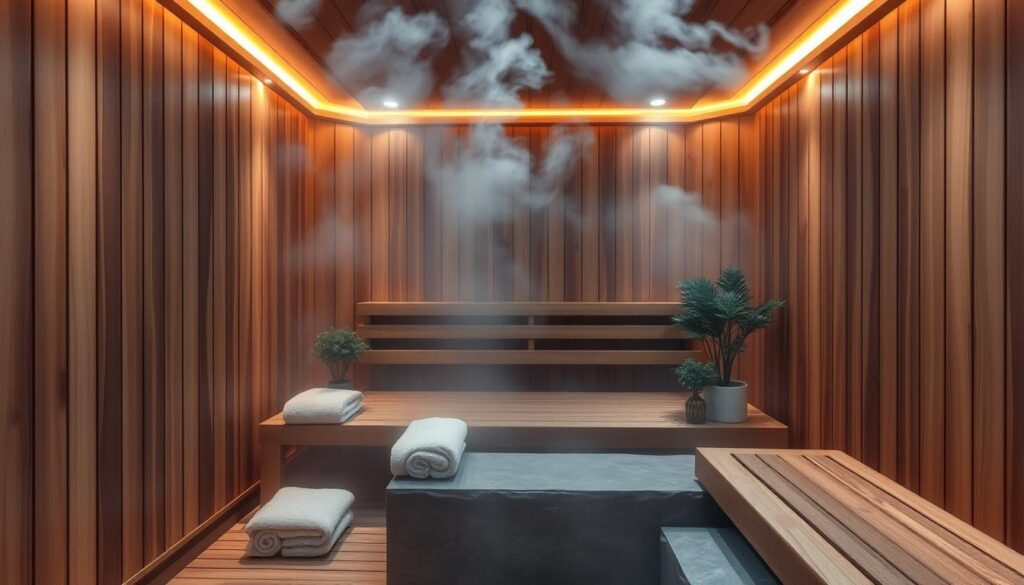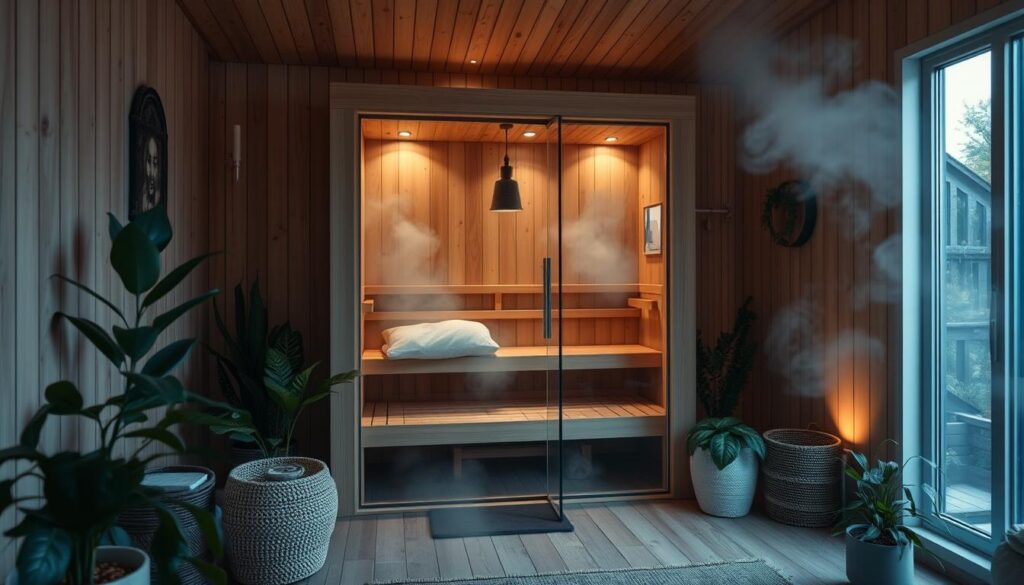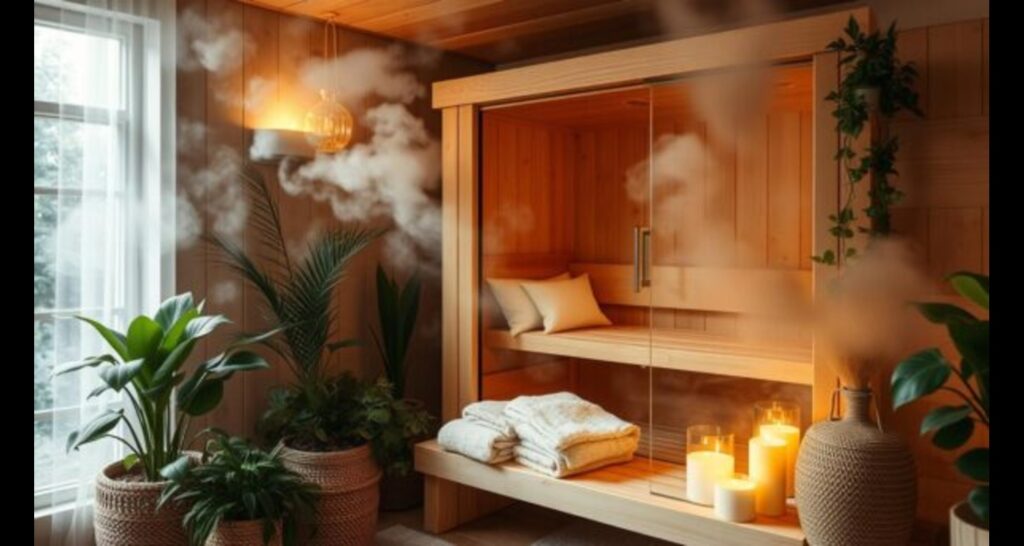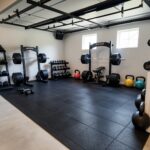Have you ever dreamed of having your oasis of relaxation right at home? Setting up a sauna home in your living space might be more accessible. In the United States, the trend of sauna home installations is gaining momentum, inspired by Nordic countries where over half the population enjoys this luxury. But how can you bring this wellness experience into your own four walls?
Creating a sauna home is a project that combines comfort with health benefits. Whether you’re considering a cozy corner in your bathroom or a standalone structure in your backyard, the possibilities for your sauna home are diverse. From traditional wood-burning styles to modern infrared options, sauna homes come in various forms to suit different preferences and spaces.
The North American Sauna Society (NASS) recognizes six types of saunas, each offering a unique experience. Dry saunas, such as wood-burning or electrically heated ones, are particularly popular for home installation due to their versatility and minimal plumbing requirements. With options ranging from compact 3×3-foot units to spacious 8×12-foot rooms, you can tailor your sauna home to fit your available space and needs.
As you embark on this exciting project, consider location, power requirements, and materials. Cedar, poplar, and hemlock are favored woods for their durability and aromatic properties. Electric heaters are a common choice for their ease of use, but gas and wood-burning options are also available for those seeking a more traditional experience.
Table of Contents
Key Takeaways
- Home saunas can be installed in spaces as small as 4×4 feet with a 7-foot ceiling
- Dry saunas are ideal for home use due to minimal plumbing needs
- Electric heaters are the most popular and convenient option for home saunas
- Cedar, poplar, and hemlock are preferred woods for sauna construction
- Proper insulation and ventilation are crucial for a safe and enjoyable sauna experience
- DIY sauna kits are available for those who prefer a guided installation process
Understanding the Benefits of Home Saunas
Home saunas bring many health benefits, making them a favorite in homes. They offer physical and mental perks, boosting overall well-being.
Physical Health Advantages
Using home saunas regularly can improve heart health. Studies show they can lower blood pressure and improve blood flow, similar to moderate exercise, as shared in the Harvard Medical School Study of the Benefits of Saunas. Infrared saunas, at 110-135°F, help muscles recover and improve sports performance.
Traditional Finnish saunas, at 170-190°F, help with pain and breathing issues.
Mental Wellness Benefits
Sauna therapy helps relax and reduce stress. Research shows it can lower anxiety and depression. The heat releases endorphins, improving mood and focus.
Some studies suggest it might also lower dementia and Alzheimer’s risk.
Enhanced Sleep Quality
Home saunas can improve sleep. The heat relaxes the body, preparing it for rest. As body temperature drops after the sauna, it signals sleep.
“Regular sauna use, about 2-3 times a week, has been linked to a 22% lower risk of sudden cardiac death compared to once-weekly use.”
While home saunas have many benefits, safety is key. Limit sessions to under 30 minutes, and drink water. Always check with a healthcare provider before starting, especially if you have health issues.
Types of Home Saunas
Home saunas come in many styles to fit different tastes and spaces. You can find everything from traditional Finnish designs to modern infrared models. There’s a sauna for every home, whether you prefer an indoor sauna or a small outdoor one.
Traditional Finnish Saunas
Finnish saunas are the classic choice. They use dry heat and sometimes steam and can get very hot, up to 195°F. An essential Finnish sauna costs around $2,000, making it a favorite for those wanting a real sauna experience.
Infrared Saunas
Infrared saunas use unique lamps to heat your body directly. They’re calmer and work between 80-130°F. Based on size and features, prices vary from $2,000 to $12,000. They’re great for those who like milder heat and are perfect for indoor use.

Steam Rooms
Steam rooms provide moist heat with 100% humidity. They’re good for your lungs and skin. Installation costs are $4,000 to $6,000. For those on a tight budget, portable steam saunas are under $100, offering a cheap way to enjoy sauna benefits.
Barrel Saunas
Barrel saunas are unique trim outdoor options. Their shape is attractive and helps heat spread evenly. They’re often cheaper than custom-built saunas, making them a favorite for backyard setups.
| Sauna Type | Average Cost Range | Key Feature |
|---|---|---|
| Finnish | $2,000 – $5,000 | High temperatures up to 195°F |
| Infrared | $2,000 – $12,000 | Lower temperatures, direct body heating |
| Steam Room | $4,000 – $6,000 | 100% humidity, respiratory benefits |
| Barrel | $3,000 – $7,000 | Efficient heat distribution, outdoor-friendly |
When picking a sauna, consider your space, budget, and what you want to get out of it. Electric and infrared saunas are suitable for indoor use, while traditional Finnish saunas offer a complete experience. Your ideal sauna is waiting for a cozy indoor spot or a charming outdoor one.
Choosing the Perfect Location for Your Sauna Home
Finding the right spot for your at-home sauna is critical for a great experience. Indoor saunas can fit in many places like basements, garages, and even closets. This makes it easy to pick a spot that matches your home and your likes.
When planning your indoor sauna, think about these essential things:
- Available space
- Proximity to utilities
- Ventilation options
- Level surface
- Electrical requirements
Make sure there’s at least 10 cm of space around your sauna for good airflow. During setup, the roof should be 60 cm above the sauna. These steps help keep the air moving and the temperature right.
Indoor saunas are popular, but outdoor ones are also an option with the right weather cover. Don’t put it on grass or rock if you’re thinking about an infrared sauna outside. Instead, use tile, concrete, or wood for a stable, lasting setup.
| Indoor Sauna Location | Advantages | Considerations |
|---|---|---|
| Basement | Privacy, plenty of room | Moisture control, air flow |
| Bathroom | Easy access to water | Less space, managing humidity |
| Garage | Far from living areas | Insulation, keeping warm |
| Closet | Space-saving | Size limits, air flow issues |
By considering these points, you can pick the best spot for your sauna at home. This will ensure that you enjoy it for many years.
Essential Considerations Before Installation
Are you thinking about setting up a home sauna? You’re in good company. Over a million saunas have been installed in the US. Before starting, thinking about a few critical things for a successful setup is essential.
Space Requirements
Size is crucial when planning a home sauna. You’ll need at least 4×4 feet with a 7-foot ceiling. You might need more space for the structure and extra features for a small outdoor sauna.
Budget Planning
Sauna costs can vary a lot, depending on the type and features. Here’s a quick look:

Remember to add the cost of heaters. Quality electric models can cost between $1,924 and $3,192.
Local Building Codes and Regulations
Before you start, check local building codes. Some places have special rules for saunas, especially outdoor ones. Make sure your sauna meets these codes to avoid problems later.

These tips will help you set up an indoor or small outdoor sauna. Proper planning ensures a safe and enjoyable sauna experience at home.
Selecting the Right Sauna Materials
Choosing the suitable materials for your sauna is critical to a great experience. Wood is essential for its role in your sauna’s life and feel. Cedar and hemlock are top picks because they keep heat in and resist scratches.
Cedar is loved for its fight against germs and its pleasant smell. Hemlock is a good choice if you want something durable but want to spend only a little. Both can handle the sauna’s hot and humid conditions well.
When building your sauna, consider using fiberglass insulation in walls and ceilings. Then, add a foil-faced vapor barrier over it, sealing the seams well. This will keep your sauna warm and protect it from moisture.
“The right materials can make or break your sauna experience. Choose wisely to ensure comfort, durability, and energy efficiency.”
Use tempered glass for doors and lights to prevent them from breaking in heat. Make sure all electrical parts can handle high humidity to stay safe. Some saunas come with wooden extras like backrests and hooks to enhance your sauna experience.
| Material | Benefits | Considerations |
|---|---|---|
| Cedar | Antimicrobial, aromatic | More expensive |
| Hemlock | Durable, cost-effective | Less aromatic than cedar |
| Fiberglass insulation | Excellent heat retention | Requires proper installation |
| Tempered glass | Heat-resistant, safe | Higher cost than regular glass |
By carefully picking these materials, you’ll make a fun sauna that lasts long and is fun to use. It will be a place of relaxation for years to come.
Sauna Heater Options: Electric, Gas, or Wood-Burning
Choosing the right heater for your home sauna is key. Each type has its own benefits and considerations. Let’s look at the options to help you decide.
Electric Heaters: Efficiency and Convenience
Electric heaters are a top choice for home saunas. They’re simple to set up and great for small areas. They need 220 volts and 30-40 amps of power.
A 6 KW heater is suitable for a 280 cubic ft sauna. They heat up in about an hour and don’t need a chimney.
Gas Heaters: Power and Flexibility
Gas heaters heat up fast, reaching temperature in 30-60 minutes. They have two ignition types: standing pilot light or automatic piezo. Gas heaters also have large rock trays for impressive steam.
They’re cost-effective, with lower operational and repair costs than electric models.
Wood-Burning Heaters: Traditional Appeal
Wood-burning heaters are great for outdoor, large saunas. They’re best for 6-person saunas or bigger. These heaters need a chimney kit and offer a real sauna experience.
However, they need to be more precise in temperature control.
| Heater Type | Annual Cost (4 uses/week) | Heating Time |
|---|---|---|
| Electric (4.5 kW) | $178.56 | 60 minutes |
| Gas (40k BTU) | $111.36 | 30-60 minutes |
| Wood-Burning | $300-$600 (per cord) | Varies |
When picking a heater for your home sauna, consider your space, budget, and what you want. Each type has its own benefits that can improve your sauna sessions.
DIY vs. Professional Installation: Making the Right Choice
Setting up a sauna home means choosing between DIY and professional installation. Each choice affects cost, quality, and time spent on it.
DIY installation can be cheaper, costing between $1,000 and $12,000. It lets you customize but takes 20 to 40 hours. You’ll need tools like a drill, saw, level, and measuring tape. You’ll also need sauna panels, benches, a door, and electrical parts.
Professional installation means getting expert work and following safety codes. It costs more but offers better safety, efficiency, and customization. Professionals have the right tools and materials, saving you time and stress.
For a compromise, think about sauna kits. They come with what you need but still let you customize. Prices start at about $4,000 for indoor kits from brands like Auroom or SaunaLife.
| Aspect | DIY | Professional |
|---|---|---|
| Cost | $1,000 – $12,000 | Higher |
| Time | 20-40 hours | Faster |
| Skill Level | Intermediate to Advanced | Expert |
| Safety Assurance | Self-managed | Guaranteed |
When planning your at-home sauna, consider your skills, budget, and time. Whether DIY or professional, insulate, ventilate, and follow local building codes. This ensures a safe and enjoyable sauna experience.
Step-by-Step Guide to Building Your Home Sauna
Building a home sauna is a detailed process. This guide will help you through the key steps, and you’ll learn how to create a relaxing and healthy space in your home.
Preparing the Location
First, make sure the area is waterproof. Basements need special care without drainage. Aim for a ceiling of at least 7 feet for comfort and bench placement.
Choose materials like cedar or hemlock for the frame. They fight mold and moisture well.
Installing Electrical Components
Electric sauna heaters are cost-effective and easy to set up. However, a certified electrician should do the wiring, as this ensures that your sauna is safe and works well.
Remember to add wet-rated sauna lights for a warm glow.
Insulation and Vapor Barrier Installation
Insulation is vital for keeping the sauna warm. Use rock wool or mineral wool to stop heat loss. A foil vapor barrier helps manage moisture.
This step is crucial for your sauna’s long life and efficiency.
Paneling and Bench Construction
Use cedar or white spruce for paneling and benches. Start with the ceiling and work down. Make benches at different levels for different heat levels.
Install a door that opens out for safety. After following these steps, you’re ready to enjoy your sauna!








3 thoughts on “How to Create the Perfect Sauna Home: 7 Essential Steps for Ultimate Wellness”